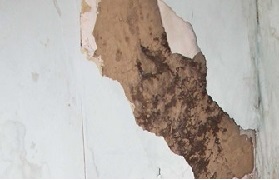ToxicBlackMould
Information about mould and mould disease
Penetrating Damp
Penetrating damp is one of the more obvious causes of damp. Winds and rain enter the building envelope either by force of gravity or are driven inside. Technically every part of the building envelope is susceptible to penetrating damp.
Roofs

Roofs are particularly at risk from penetrating damp. The basic protection of the roof is its pitch which is quite steep in climates with lot of rain and shallow in drier climates. The roofs are traditionally constructed from materials such as thatch, slate, fired clay and synthetic tiles. Metal such as lead, copper and zinc have also been used by are not frequently used for residential housing. The most vulnerable areas of any roof construction are hips, valleys, verges are any other area of bonding.
Thatched roofs
Typical life span of a thatched roof is between 30 and 40 years depending on the particular construction details and quality of workmanship. Thatched roof suffer from progressive natural decay by fungi. Once the surface layer deteriorates the whole process accelerates because water can enter deeper into the structure. Typically the only viable solution is the replacement of the decayed structure.
Shingles
Shingles are mostly made of western red cedar, oak or other durable woods. These woods contain high quantities of preserving oil helping them to ward of decay. The typical life span of a shingle roof is about 60 years.
Clay and concrete tiles
Both types have a very high durability and typical life span exceeds decades but is dependent on workmanship and physical damage to the tiles. In practice the most common reason for rain penetration is that the roof pitch is not sufficient. In severe cases moss starts to grow and damages the tiles. In overall the defects causing penetrating damp can be causes either by failure of individual tiles or failure of the whole roof tile system.
Chimneys
Chimneys are very vulnerable to penetrating damp due to the nature they are designed. The allow smoke to escape the property but relay on strong updraft to prevent rain getting in. Chimney stack should always be covered and in particular when they are not used frequently. Traditional chimney stacks will absorb water through the sides of the stack and well as through the pots and can result in significant damp problems. The combination of long term deposit of sooth and other chemicals creates corrosive condition affecting the mortar between the stacks bricks.
Roof lights
In most cases the water penetrates roof light structure either through surrounding flashing or through he glazing frame itself. Generally the replacement of the whole component is the most suitable treatment option. Sometimes replacement of deteriorated seals with silicon sealant or neoprene gasket can resolve the problem.
Dormers
They are one of the most vulnerable structures of the whole roof systems due to the fact they contain the whole range of roof components. They are particularly vulnerable to wind and weather damage.
Vents
Most vent fail and cause damp problems because they were incorrectly fitted.
Walls
The difference between rising damp and penetrating damp as far as walls are concern is that the penetrating damp affects walls to any high creating patches. They may be worst at lower level due to the combination of rising and penetrating damp or just because the water penetrates the structure at lower level. Solid walls usually fail due to the deterioration of the wall mortar or due to the damage to the wall itself.
Cavity walls
Cavity walls were developed especially to prevent water penetration into the inner leaf of the structure. The principal function of the outer leaf is to act as a weather shield. Water does not come into contact with the inner leaf of the building structure unless this cavity is bridged.
Failure of the cavity wall can occur due to the failure or improper installation of wall tiles. Another component likely to fail is cavity wall insulation. The most likely cause of failure is bridging of the cavity with mortar.
Wall cladding
There is a large range of materials used for external building cladding each with its own method of installation and range of components which may fail. Render is by far the most commonly used material to provide external building cladding. Render cladding is prepared by application of cement and sand to ventricular surface to form weather resistant layer. It can fail through cracking, debonding form the underlying wall or decay of the render.
